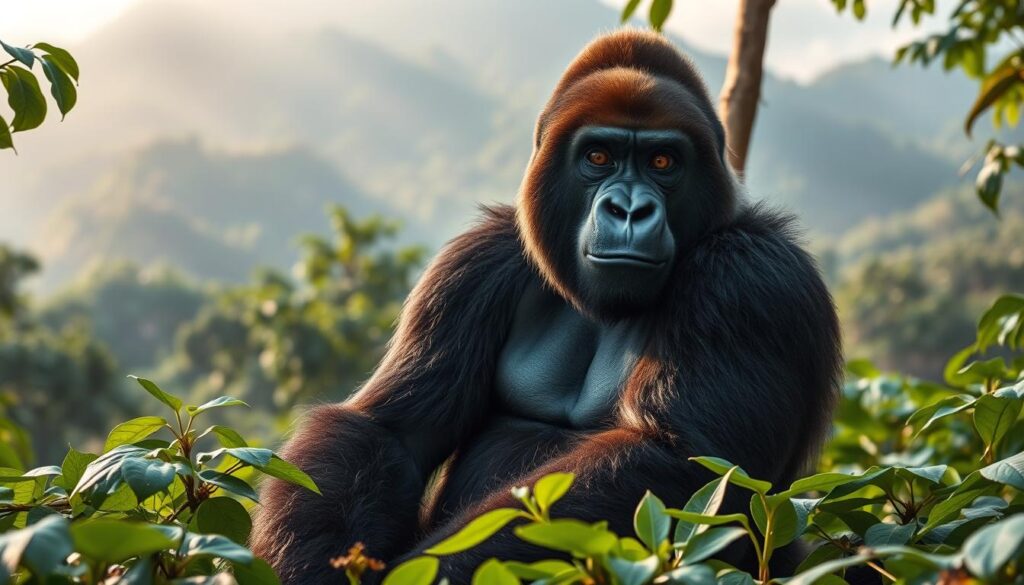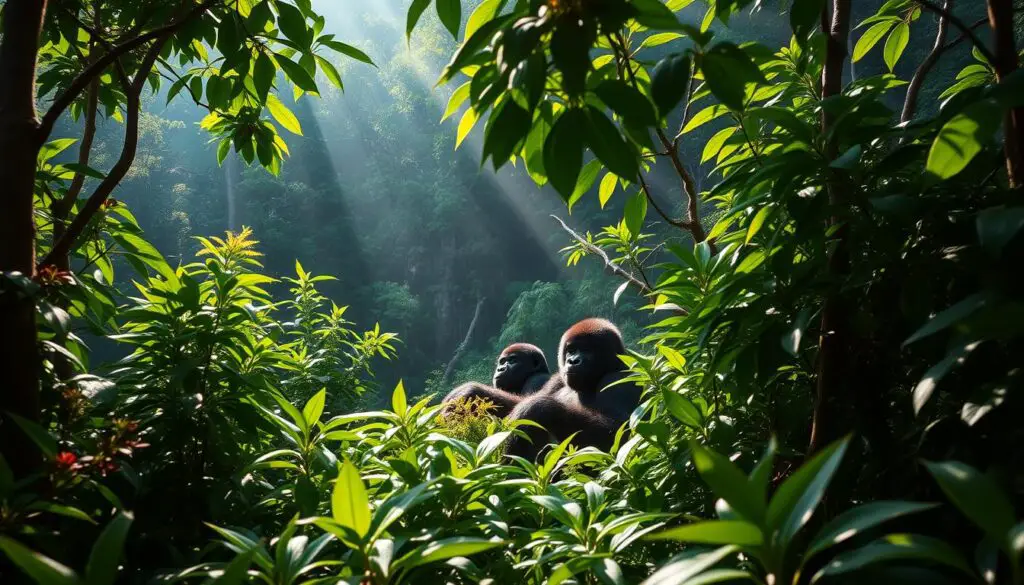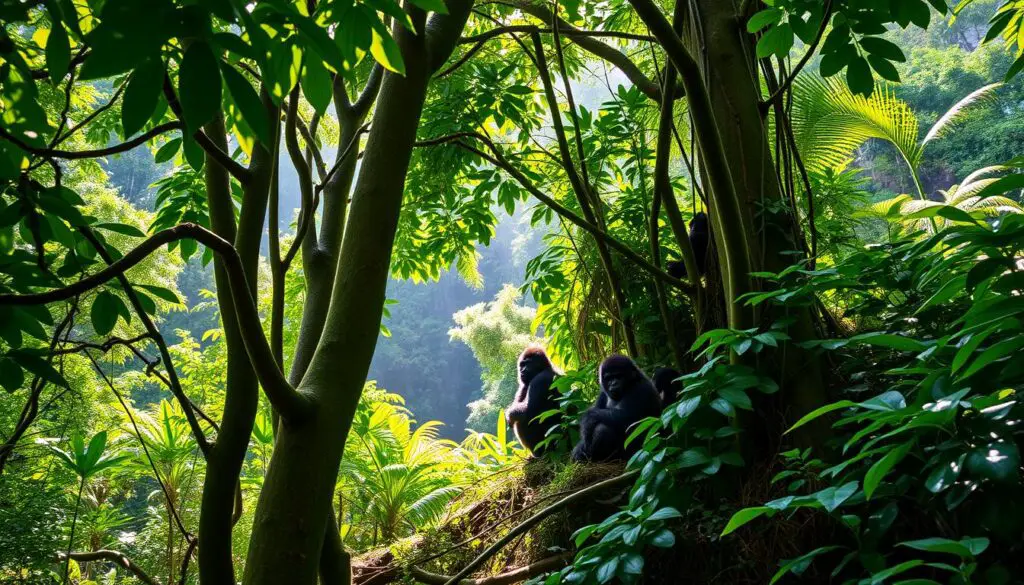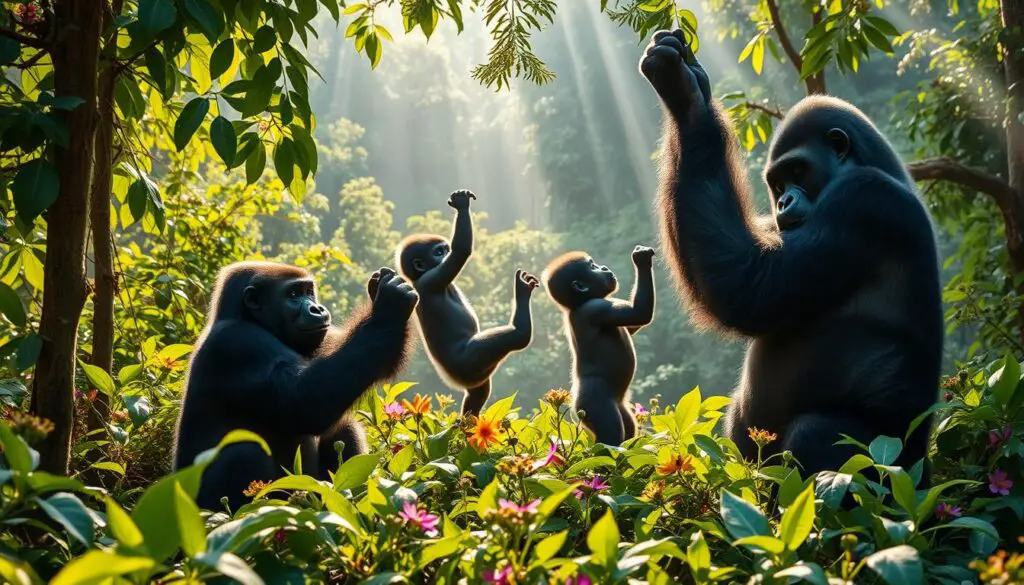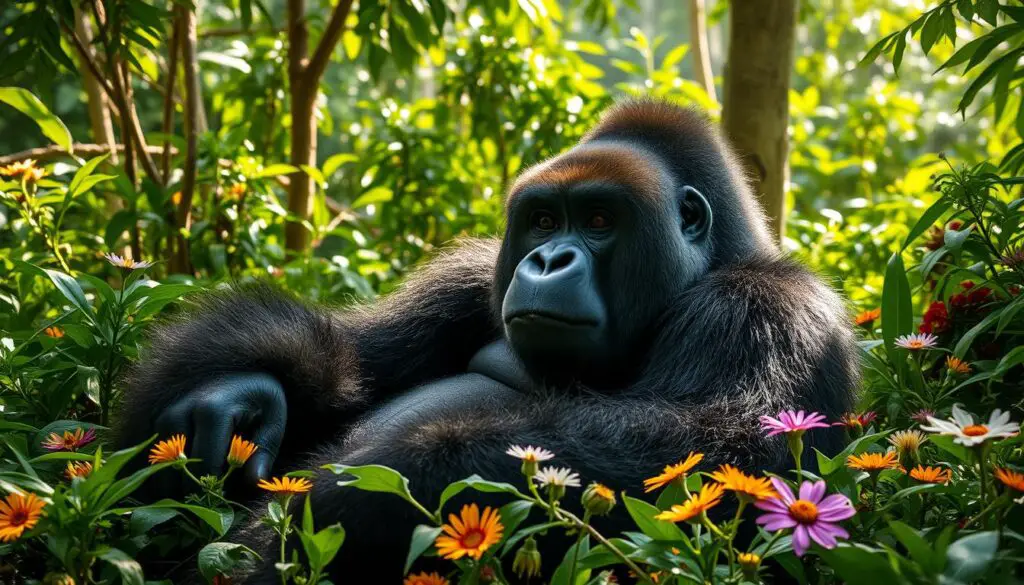Standing in the misty rainforest, I felt my heart beat fast. The mountains in the distance seemed to grow taller. I was about to see mountain gorillas up close. Trekking in Bwindi Impenetrable National Park in Uganda was a dream come true.
Mountain gorillas live in only two places on Earth. Uganda has nearly half of them. These gentle giants and their family bonds touch everyone’s heart.
Key Takeaways
- Uganda is home to nearly half of the world’s remaining mountain gorilla population.
- Bwindi Impenetrable National Park and Mgahinga Gorilla National Park offer unparalleled opportunities to observe these endangered primates.
- Trekking through the dense rainforests to encounter gorilla families is a once-in-a-lifetime wilderness adventure.
- Gorillas share 98% of their DNA with humans, making the connection between the two species truly remarkable.
- Conservation efforts have played a crucial role in the recovery of mountain gorilla numbers, from a perilously low 280 in the 1980s to around 1,000 today.
Introduction to Mountain Gorillas in Uganda
Uganda is home to some of the world’s last remaining mountain gorillas. These animals are found in the rugged and lush forests of East Africa. They share an amazing 98% of their DNA with humans, captivating many.
The Last Remaining Mountain Gorillas
Mountain gorillas live in just two places: Rwanda’s Volcanoes National Park and Uganda’s Bwindi Impenetrable Forest. In the 1980s, there were only 280 of them. But thanks to conservation, over 1,000 now thrive.
Conservation Success Story
The mountain gorilla’s recovery is a big win for conservation. Things like park guards, better vet care, and Primate Watching and Ecotourism in Africa helped. Today, Uganda’s Bwindi Impenetrable National Park has over 786 mountain gorillas, making it a top spot for Sustainable Tourism.
DNA Connection to Humans
Mountain gorillas and humans are more alike than you might think. They share 98% of their DNA and show human-like behaviors like humming. This shows how important it is to protect them, as their survival is linked to ours.
“The mountain gorilla is not just a primate, but a living, breathing reminder of our own evolutionary journey. Protecting these magnificent creatures is a responsibility we all share.”
Discovering Bwindi Impenetrable National Park
Bwindi Impenetrable National Park is in the southwestern corner of Uganda. It’s the top spot for the Gorilla Habituation Experience and a real Wilderness Adventure. This UNESCO World Heritage Site has nearly 20 gorilla families. They are spread across four sectors: Buhoma, Ruhija, Rushaga, and Nkuringo.
The park is famous for its amazing biodiversity. It has misty rainforests, tall mountains, and rough terrain. Trekking here means walking on trails, often with guides cutting through thick plants. The lack of roads or paths makes the experience truly wild.
| Key Facts about Bwindi Impenetrable National Park |
|---|
| – Uganda is home to over half of the world’s remaining mountain gorillas |
| – Gorilla permits from the Uganda Wildlife Authority cost $700 per person |
| – Gorilla treks at Bwindi can last 7 hours or more |
| – Gorilla trek groups are limited to eight people to keep the gorillas safe and increase chances of sightings |
| – Bwindi Impenetrable Forest National Park is located in southwestern Uganda |
The Gorilla Habituation Experience in Bwindi is unforgettable. Trekking through dense forests, you can see gorillas up close. You’ll also see the park’s beauty and diverse wildlife.
“Gorilla trekking in Uganda is significantly cheaper than in neighboring Rwanda, where permits cost $1,500 year-round.”
If you want an exciting Wilderness Adventure or a unique Gorilla Habituation Experience, Bwindi is the place. Plan your trek now. It’s a journey that will amaze you with the mountain gorillas and the park’s wonders.
The Fascinating Life of Gorilla Families
Exploring Bwindi Impenetrable National Park in Uganda is a rare chance to see wild mountain gorillas. These gentle giants are our closest relatives. They live in family groups, led by a strong silverback male.
The silverback is about 170 cm tall and can weigh up to 180 kg. He protects and makes decisions for his family.
Social Structure and Hierarchy
A gorilla family has 10 to 12 members, including the silverback and adult females with their kids. The family has a clear order, with the silverback leading. Adult females and their young are the heart of the group. Young male gorillas, or blackbacks, find their place as they grow older.
Daily Routines and Behaviors
Gorillas spend their days foraging, eating, resting, and playing. They make nests from leaves and twigs to sleep. They don’t drink much water, getting moisture from leaves and dew.
Despite their size, gorillas are wary of water. They use natural bridges to cross streams and rivers.
Unique Characteristics
Mountain gorillas have thick, silver-gray fur that helps them in the cool, misty forests. They are known for their chest-beating displays, which they use to communicate and show dominance. Watching gorilla babies and young ones play is fascinating.
“Encountering a charging silverback gorilla, like Makara from the Habinyanja family, can be an intense part of the experience, with respect and stillness expected from trekkers.”
The similarities between gorillas and humans, sharing 98% of their DNA, make them fascinating. By learning about gorilla families, we can understand why protecting them and their habitats is crucial.
Planning Your Gorilla Trek Adventure
Going on a Mountain Gorilla Safari in Uganda is a unique experience. But, planning it well is crucial. The trek can take from 1 to 6 hours, based on where the gorillas are. It starts early, with a briefing at the park headquarters.
Here, you’ll join a group of 8 or fewer for a specific gorilla family. The trek goes through dense vegetation, sometimes on slippery slopes. You need to be somewhat fit because of the terrain and altitude.
Start getting ready a week before your trek. This will help you enjoy the adventure more. Basic exercises are recommended.
Booking your trip early is important. It helps with accommodation, permits, and transport. A one-day gorilla trek in Uganda costs about $970. The 4-day Home to Africa safari, including gorilla trekking, is $1,364, with $700 for the permit.
Bwindi Impenetrable National Park has a tough terrain. It offers four trekking areas with different gorilla groups and places to stay. Uganda has more permits than Rwanda, thanks to its larger gorilla population.
“The Uganda gorilla trekking tour typically lasts the entire day, starting at sunrise and ending before sunset.”
Good planning is essential for a great Mountain Gorilla Safari in Uganda. Knowing what to expect, getting permits, and arranging logistics increases your chances of seeing gorillas. It also supports Ecotourism in Africa.
Essential Trek Preparation and Requirements
Going on a Wilderness Adventure to see mountain gorillas in Uganda needs careful planning. Being physically fit is key, as the trek is tough. You’ll walk through Bwindi Impenetrable National Park on challenging terrain. You’ll need sturdy hiking boots, long clothes, and rain gear for comfort and safety.
Physical Fitness Requirements
Gorilla trekking is an exciting Wilderness Adventure. But, it demands a good level of physical fitness. You’ll hike for hours in dense forests, facing steep paths and uneven ground. Be ready for the physical demands, as it can be tough.
Proper Gear and Equipment
Having the right gear is vital for a great gorilla trekking experience. Sturdy hiking boots, long clothes, and rain gear keep you safe and comfortable. Don’t forget a backpack, water, snacks, and personal items.
Best Time to Visit
The best time for gorilla trekking in Uganda varies based on your plans. The dry seasons, from June to August and December to February, make trekking easier. But, trekking is possible all year, and the wet seasons offer lush, green landscapes.
“Gorilla trekking is a once-in-a-lifetime experience that allows visitors to witness the fascinating behaviors and social dynamics of these gentle giants in their natural habitat.”
The Sustainable Tourism opportunities in Uganda are worth exploring. With the right preparation and a sense of adventure, you’ll have an unforgettable journey. You’ll see these amazing primates and the beautiful landscapes of Bwindi Impenetrable National Park.
Gorilla Trekking in Uganda: A Once-in-a-Lifetime Experience
Going on a gorilla trekking adventure in Uganda is unforgettable. Seeing the majestic mountain gorillas is a rare moment. It leaves a deep mark on your heart and mind.
During this special hour, you get to see gorillas in their natural home. You’ll watch them eat, play, and rest. It’s a surreal experience that changes your life, connecting you with our closest animal relatives.
Uganda is a key place for Wildlife Conservation and responsible tourism. It’s home to over half of the world’s mountain gorillas. Expert trackers lead you through Bwindi Impenetrable National Park or Mgahinga Gorilla Park. You’ll follow gorilla families and explore the natural world.
| Statistic | Value |
|---|---|
| Chance of seeing mountain gorillas in their natural habitat | 99% |
| Minimum age limit for gorilla trekking | 15 years |
| Maximum time allowed with mountain gorillas during viewing | 1 hour |
The best part of your trek is meeting the gorilla family. You’ll see a silverback, playful kids, or a mother caring for her baby. These moments change you, making you appreciate Wildlife Conservation more.
“99% of trekkers experience a jaw-dropping moment during gorilla encounters.”
For a deeper experience, try the Gorilla Habituation Experience. It’s a four-hour interaction with a gorilla family. You can see their behavior up close.
Gorilla trekking in Uganda is a once-in-a-lifetime experience. With Uganda’s focus on Wildlife Conservation, your adventure helps protect these amazing animals.
Safety Guidelines and Interaction Rules
When you go on a Gorilla Habituation Experience in Uganda, following safety rules is key. These rules help keep the mountain gorillas safe and make sure you have a good time.
Distance Requirements
You must stay at least 7 meters (21 feet) away from the gorillas. This keeps them calm and stops them from getting upset. Gorilla trekking groups are limited to a maximum of 8 individuals, and treks last about an hour to not disturb the gorillas too much.
Communication Guidelines
Talking softly and not staring at the gorillas is important. Flash photography is strictly prohibited to keep the experience peaceful for everyone.
Safety Protocols
In Uganda, Rwanda, and the Democratic Republic of the Congo, armed rangers keep you safe. Hiring local guides and porters is encouraged to make your trip better and support local communities.
These rules are in place to protect both the gorillas and you. By following them, you’ll have a safe and unforgettable experience.
“It is a legal requirement to have a knowledgeable guide accompany visitors during gorilla treks to ensure safety for both tourists and the gorillas.”
Conservation Efforts and Sustainable Tourism
Gorilla trekking in Uganda is key to wildlife conservation. The money from permits and tourism funds protection and helps local people. Researchers and vets join treks to study and care for the gorillas. This way, tourism is done in a way that protects the gorillas and their home while helping local people and conservation.
The cost for a one-hour gorilla trek in Bwindi Impenetrable Forest is $800 as of 2024. For $1,500, you can join a habituation process, spending more time with the gorillas. These high fees help the Uganda Wildlife Authority (UWA) fight poaching, restore habitats, and do research.
Responsible ecotourism in Africa also helps local communities. Trekking creates jobs for guides, porters, and lodge staff. A part of the fees goes to community projects for better infrastructure, education, and healthcare. Keeping a safe distance from the gorillas is crucial for protecting them and helping local people.
| Key Sustainability Statistics | Value |
|---|---|
| Mountain Gorilla Population in Uganda | Over 1,000 as of 2018 |
| Contribution of Tourism to Uganda’s GDP | 5.9% in 2019 |
| Number of Full-time and Casual Staff Employed by Volcanoes Safaris | Over 500 |
Uganda faces challenges in being known internationally. But, its dedication to wildlife conservation and ecotourism in Africa is clear. As the gorilla population grows and tourism becomes more important, the need for responsible tourism will grow too.
“Sustainable tourism practices during gorilla trekking are essential for balancing wildlife conservation, environmental preservation, and economic benefits for local communities.”
Cultural Immersion and Local Communities
Going on a gorilla trek in Uganda is more than just seeing amazing animals. It’s a chance to dive into local culture and connect with communities. You can join projects that help the area grow and learn about its rich history.
Community Benefits
Lodges and tour groups in Uganda team up with local people. This makes sure tourism helps more than just animals. It supports schools, health care, and jobs for the locals.
This way, visiting gorillas is a win-win. It brings people together and helps the community grow.
Cultural Experiences
There’s more to Uganda than gorillas. You can try making baskets with local women or watch dances by the Batwa people. These moments show the area’s rich culture.
By talking to locals and learning about their lives, you’ll see the gorillas’ home in a new light. You’ll understand why their habitat is so special.
Local Initiatives
Uganda’s tourism is about more than just animals. Lodges and tours support projects that help the community and the planet. You can help by planting trees, cleaning up, or learning in schools.
These efforts make your visit more meaningful. They show that everyone can help protect Uganda’s beauty for the future.
